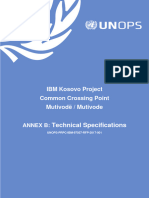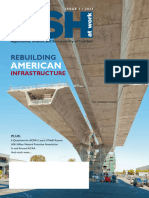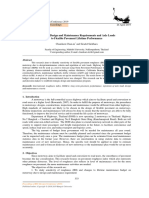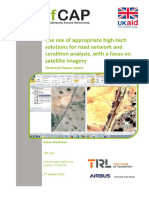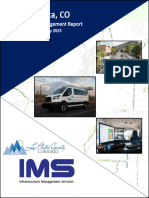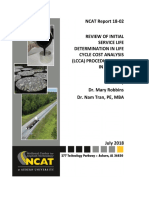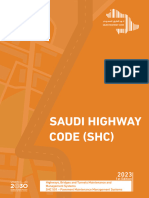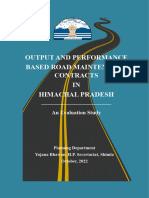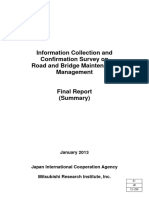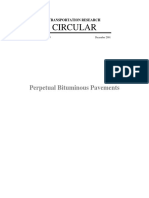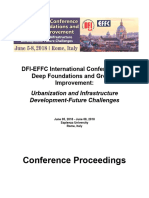Professional Documents
Culture Documents
Iso 4892 2 2006
Uploaded by
Khin Khin Thaw100%(1)100% found this document useful (1 vote)
334 views15 pagesOriginal Title
ISO-4892-2-2006
Copyright
© © All Rights Reserved
Available Formats
PDF or read online from Scribd
Share this document
Did you find this document useful?
Is this content inappropriate?
Report this DocumentCopyright:
© All Rights Reserved
Available Formats
Download as PDF or read online from Scribd
100%(1)100% found this document useful (1 vote)
334 views15 pagesIso 4892 2 2006
Uploaded by
Khin Khin ThawCopyright:
© All Rights Reserved
Available Formats
Download as PDF or read online from Scribd
You are on page 1of 15
INTERNATIONAL Iso
STANDARD 4892-2
‘Second edition
2006-02-01
Plastics — Methods of exposure to
laboratory light sources —
Part 2:
Xenon-arc lamps
Plastiques — Méthodes d'exposition a des sources lumineuses de
laboratoire —
Partie 2: Lampes a arc au xénon
504892-7-2008
Reference number
1S0 4892-2:2006(€)
180 2006
POF disclaimer
‘This POF fle may contain embedded tvpefaces. tn accordance with Adobe's licensing policy. this file may be printed or viowed but
‘shall not be edited unloss the typafacas which are embedded are Neensed to and installed en the compiter performing the edting. In
doanlosding this flo, parties accept therein the responsibilty of not intinging Adobe's licensing poly. The ISO Central Secrotariat
‘accepts no lability inthis area.
‘Adobe Isa trademark of Adobe Systems Incorporated
Details ofthe software products used to create this PDF fle can be found in the General Info relative to the file: the PDF-creation
paremeters were optimized for printing. Evory care has been taken fo ensure thatthe fils suitable for use by ISO member bodies. Ia
{he unlikely event tht a problem relating to itis found, please inform the Central Secretariat atthe address given below.
© 180 2008
Al
lights reserved. Unless otherwise specified, no part ofthis publication may be reproduced or utlized in ary form or by any means,
‘electronic or mechanical, including photocopying and micrafim, without permission in wring from either ISO at the address below of
180's member body in the county of the requester.
180 copyright office
(Case postale 56 © CH-1211 Geneva 20
Tel. #41 227490111
Fax +41 22749 09.47
E-mail copyright @iso.ceg
Web wow leo.0rg
Published in Switeeriand
© 180.2006 ~ Al rights reserved
Contents Page
Foreword.
Scope...
Normative references.
Exposure conditions
Procedure ..
eran nena
Exposure report.
Annex A (informative) Filtered xenon-arc radiation — Spectral power distributio
Bibliography.
© 180 2006 —Altrights reserved ii
:2006(E)
Foreword
1SO (the Intemational Organization for Standardization) ie a worldwide foderation of national atandards bo
(ISO member bodies). The work of preparing Intemational Standards is normally carried out through |SO
technical committees. Each member body interested in a subject for which a technical committee has been
established has the right to be represented on that committee. international organizations, governmental and
non-governmental, in ligison with ISO, also take part in the work. ISO collaborates closely with the
International Electrotechnical Commiozion (IEC) on all matters of eleetrotechnical standardization.
International Standards are drafted in accordance with the rules given in the ISO/IEC Directives, Part 2.
The main task of technical committees is to prepare International Standards. Draft International Standards
‘adopted by the technical committees are circulated to the member bodies for voting. Publication a5 an
Intemational Standard requires approval by at least 75 % of the member bodies casting a vole.
Attention is drawn to the possibilty that some of the elements of this document may be the subject of patent
tights. ISO shall not be held responsible for identifying any or all such patent rights. .
ISO 4892-2 was prepared by Technical Committee ISO/TC 61, Plastics, Subcommittee SC6, Ageing,
chemical and environmental resistance.
This second edition cancels and replaces the first edition (ISO 4892-2:1994), which has been technically
revised.
1SO 4892 consists of the following parts, under the general title Plastics — Methods of exposure to laboratory
light sources:
— Part 1: General guidance
— Part 2: Xenon-arc lamps
— Part 3: Fluorescent UV lamps
— Part 4: Open-flame carbon-arc lamps
iv © 180 2006~ All rights reserved
INTERNATIONAL STANDARD
Plastics — Methods of exposure to laboratory light sources —
Part 2:
Xenon-arc lamps
4 Scope
Thio part of IS0 4802 specifies methods for exposing specimens to xenon-arc light in the presence of
moisture to reproduce the weathering effects that occur when materials are exposed in actual end-use
environments to daylight or to daylight fitered through window glass.
The specimens are exposed to filtered xenon-are light under controlled conditions (temperature, humidity
and/or wetting). Various types of xenor-arc light source and various filter combinations may be used to meet
different requirements,
‘Specimen preparation and evaluation of the results are covered in other International Standards for specific
materials,
General guidance is given in ISO 4892-1
NOTE —_Xenon-are exposures of paints and vamishes are described in ISO 11341.
2 Normative references
The following referenced documents are indispensable for the application of this document. For dated
references. only the edition cited anplies. For undated references, the latest edition of the referenced
document (including any amendments) applies.
180 4582, Plastics — Determination of changes in colour and variations in properties after exposure to
daylight under glass, natural weathering or laboratory light sources
ISO 4892-1, Plastics — Methods of exposure to laboratory light sources — Part 1: General guidance
3. Principle
3.1 A.xenon are, fited with suitable filters and properly maintained, is used to simulate the spectral power
distribution of daylight in the ultraviolet (UV) and visible regions of the spectrum.
3.2 Specimens are exposed to various levels of light, heat, relative humidity and water (see 3.4) under
controlled environmental conaitions,
3.3. The exposure conditions may be varied by selection of
a) the light fiter(s);
b) the irradiance level,
© 150 2006 ~All rights reserved 1
¢) the temperature during exposure to light;
@) the relative humidity in the chamber during light and dark exposures, when exposure condilions requiting
control of humidity are used;
) the way the test specimens are wetted (see 3.4);
1) the water temperature and wetting cycle;
9) the relative lengths of the light and dark periods.
3.4 Wetting is usually produced by spraying the test specimens with demineralized/deionized water, by
Immersion in water or by Condensation of water vapour onto the surfaces of the specimens.
3.5 The procedure may include measurements of the irradiance and radiant exposure in the plane of the
specimens.
3.6 _It is recommended that a similar material of known performance (a control) be exposed simultaneously
with the test specimens to provide a standard for comparative purposes.
3.7 _ Intercomparison of results obtained from specimens exposed in different apparatus should not be made
unless an appropriate statistical relationship has been established between the apparatuses for the particular
‘material exposed.
4 Apparatus
44 Laboratory light source
44.1 General
The light source shatl comprise one or more quartz jacketed xenon-arc lamps which emit radiation from below
270 nm in the ultraviolet through the visible spectrum and into the infrared. In order to simulate daylight, filters.
shall be used to remove short-wavelength UV radiation (method A, see Table 1). Filters to mi irradiance
at wavelengths shorter than 310 nm shail be used to simulate daylight through window glass (method B, see
Table 2). In addition, filters to remove infrared radiation may be used to prevent unrealistic heating of the test
specimens, which can cause thermal degradation not experienced during outdoor exposures.
NOTE __ Solar spectral irradiance for a number of different atmospheric conditions is described in CIE Publication
No. 85. The benchmark daylight used in this part of ISO 4892 is that defined in Table 4 in CIE No. 85:1989.
44.2. Spectral irradiance of xenon-arc lamps with daylight filters
Filters are used to filter xenon-are emissions in order to simulate daylight (CIE Publication No. 85:1989,
Table 4). The minimum and maximum levels of the relative spectral irradiance in the UV wavelength range are
given in Table 4 (see also Annox A).
2 © ISO 2006 - All rights reserved
443
Filters are used to filter the xenon-arc lamp e
‘Spectral passband (GI No, 05:1909, Table 4"
(= wavelength in nm) % % %
45200 0,15
290 <4< 320 26 54 78
320.<4.< 360 28,2 38.2 39.8
360 (method B)
‘Spectral passband Minimum © (CIE No. 86:1989, Table 4
plus effect of window glass %®
(2= wavelength innm) % ‘
A= 300) 0,29
300 << 320 0.4 <1 2.8
320 The minimum and maximum fimits in this table are based on more than 30 spectral radiance measurements with
|water- and sir-cocled xenen-arc tamps with window glass fitere from different production lote and of various ages |,
fused in accordance with the recommendations of the manufacturer. As more epectzal iradance data become
avalable, minor changes in the mis ere possibfe, The minimum and maximum mits ere atleast three sigma from the
mean for all the measurements.
© The minimum and maximum columns will not necessary sum to 100 % because they represent the minima and}
maxima for the data used. For any individual spectral radiance, the percentages calculated forthe passbands in tis
table wil sum to 100 %. For any individual xenon-arc lamp wit window glass fiters, he calculated percentage in each
passband shall fall within the minimum and maximum limits given. Exposure results can be expected to differ if
obtained using xenon-are apparatus in which the spectral iradiances differ by as much as that allovred by the
tolerances. Contact the manufacturer ofthe xenon-are apparatus for specific spectra iradiance data fr the xenon-ae|
iamp end fiters used.
+The data from Table 4 in CIC No. 05:1909 plus the effect of window glass was determined by mutiplying the CIE
No. €5:1989, Table 4, data by the spectral transmittance of 8-mm-ihick window glass (see ISO 11341). These data ae|
target values for xenon-arc lamps with window glass fiters.
}° For the CIE No. 85:1989 plus window glass data, the UV radiance between 300 nm and 400.nm is typically
labout 9% and the visible iradiance (between 400hm and 800 nm) Is typically about 91%, expressed as a
percentage of the total radiance between 200 nm and 800 nm. The percentage of the UV irradiance and that ofthe
Viele adianca incident on specimens exposed In xenon-are apparatus may vary dua to the number of specimens
boing exposed and their reflectance properties.
44.4. irradiance uniformity
‘The irradiance at any position in the area used for specimen exposure shall be at least 80 % of the maximum
irradiance. Requirements for periodic repositioning of specimens when this requirement is not met are
described in ISO 4892-1.
NOTE For some materials of high reflectivity, periodic repositioning of specimens is recommended to ensure
Uniformity of exposures, even whien the irradiance uniformity in the exposure area Is within the limits so that repositioning
isnot required.
4.2 Test chamber
The design of the test chamber may vary, but it shall be constructed from inert mate
controlfed irradiance, the test chamber shall provide for control of temperature. For exposures that require
control of humidity, the test chamber shall include humidity-control facilities that meet the requirements of
180 4802-1, When required by the exposure used, the epparatus shall also include facilitics for the provision
‘of water spray or the formation of condensate on the surface of the test specimens, or for the immersion of the
‘specimens in water. Water used for water spray shall meet the requirements of ISO 4892-1.
The light source(s) shall be located, with respect to the specimens, such that the irradiance at the specimen
surface complies with 6.1.
4 (© 1802006 — All rights reserved
ISO 4892-2:2006(E)
NOTE Ifthe lamp system (one or more lamps) is centrally positioned in the chamber, the effect of any eccentricity of
the lamp(s) on the uniformity of exposure may be reduced by using a rotating frame carrying the specimens or by
repositoning or rotating ine lamps.
‘Should any ozone be generated from operation of the lamp(s), the lamp(s) shall be isolated from the test
specimens and operating personnel. If the ozone is in an air stream, it shall be vented directly to the outside of
the building,
4.3 Radiometer
When a radiometer is used, it shall comply with the requirements outlined in ISO 4892-1.
4.4 Black-standard/black-panel thermometer
‘The black-standard or black-panel thermometer used shall comply with the requirements for these devices
given in ISO 4892-1.
4.5 Wetting and humidity-contro! equipment
45.41 General
Specimens may be exposed to moisture in the form of water spray or condensation, or by immersion. Specific
‘exposure conditions using water spray are described in Table 3. if condensation, immersion or other methods
are used to expose the specimens to moisture, details of the procedures and exposure conditions used shall
be included in the exposure report.
Table 3 also describes exposure conditions in which the relative humidity is controlled as well as those in
which humidity control is not required.
NOTE The relative humidity ofthe air can have a significant infuence on the photodegradation of polymers.
45.2. Relative-humidity control equipment
For exposures where relative-humidity control is required, the location of the sensors used to measure the
humidity shall be as specified in ISO 4892-1,
45.3 Spray system
The test chamber shall be equipped with a means of directing an intermittent water spray onto the fronts or
hacks of the test specimens under epecifiod conditions, The apray shall be uniformly distributed over the
specimens. The spray system shall be made from corrosion-resistant materials that do not contaminate the
water employed.
The water sprayed onto the specimen surfaces shall have a conductivity below 5 yS/om, contain less than
1 pola dissolved eolide and fcave no observable stains or deposits on the specimens. Care shall be taken to
keep silica levels below 0,2 ug/g. A combination of deionization and reverse osmosis can be used to produce
water of the desired quality.
4.6 Specimen holders
‘Specimen holders may be in the form of an open frame, leaving the backs of the specimens exposed, or they,
may provide the specimens with a solid backing. They shall be made from inert materials that will not affect
the results of the exposure, for example non-oxidizing alloys of aluminium or stainless steel, Brass, steel or
‘copper shall not be used in the vicinity of the test specimens. The backing used may affect the results. as may
any space between the backing and the test specimen, particularly with transparent specimens, and shall be
agreed on between the interested parties.
(© 1SO 2006 ~ Allrights reserved 5
:2006(E)
4.7 Apparatus to assess changes in properties
The apparatus required by the Intemational Standards relating to the determination of the properties chosen
for monitoring (see also ISO 4582) shall be used.
5 Test specimens
Refer to ISO 4892-1.
6 Exposure conditions
6.1 Radiation
Unless otherwise specified, contral the irradiance at the levels indicated in Tahla 3. Other irradiance levels
may be used when agreed on by the interested parties. The irradiance, and the passband in which it was
measured, shall be included in the exposure report.
6.2 Temperature
6.2.1 Black-standard/black-panel temperature
For referee purposes, Table 3 specifies black-standard temperatures. For normal work, black-panel
thermometers may be used in place of black-standard thermometers. However. allowance will have to be
made for the fact that the two types of thermometer indicate different temperatures, due to their different
thermal conductivities (see ISO 4892-1).
NOTE 1 — Ifablack-panel thermometer is used, the temperature indicated will be 3 °C to 12 °C lowor than that indicated
bya black-standard thermometer under typical exoosure conditions.
Ifa black-panel thermometer is used, then the panel material, the type of temperature sensor and the way in
which the sensor is mounted on the panel shall be included in the exposure report.
NOTE2 If hicher temperatures (see cycles 3. 4 7 and 8 in Table 3) are used for special exposures, the tendency for
specimens to undergo thermal degradation will increase and this may affect the results of such exposures.
Other temperatures may be used when agreed on by the interested parties, but shall be stated in the
exposure report.
If water spray is used, the temperature requirements apply to the end of the dry period. If the thermometer
does not reach a steady state during the short water-spray part of the cycle, the temperature specified shall be
established without water spray and the maximum temperature attained during the dry part of the cycle shall
bbe reported,
NOTE 3 The additional measurement of a white-standard/white-pane! temperature with a white-standard/white-panel
thermometer according o 180 4892-1 gives important information on the range of surface temperatures of differonty
coloured test specimens.
6.22 Chamber air temperature
Exposures can be run either with the chamber air temperature controlled at a specified level or allowing the air
temperature to find its own level (see Table 3).
6.9 Relative humidity of chamber air
Exposures can be conducted either with the relative humidity controlled at a specified level or allowing the
relative humidity to find its own level (see Table 3).
6 © ISO 2006 — All rights reserved
Iso 4892-2:2006(E)
Table 3— Exposure cycles
[metnoa A— Exposures using daylight fiers (artificial weathering)
radiance Black-standard| Chamber | Relative
el | eewosure pred |, Benand Negzond | temperature | temperate | unity
Wim? ‘Wilm?-nm) 4 a ee
102 min dry ostzoc | 6543 3823 502108
18minwaterspray| _60£2 0514002 - - =
> | weminary 022 0514002 | 6523 | Noteoniroled | Notcontroted
18 minwaterspray| 602 051002 = = =
3 | 2minary 6022 osiz002 | 10043 0523 20210
t8minwaterspray| 6042 0.51 £002 7 7 -
102 min dry 022 oste002 | 10023 | Notcontoled | Notcontroted
18 min water spray 60+2 0,51 0,02 = = =
Method B — Exposures using window glass filters
lrradiance*
[Black-standard| Chamber Relative
Cycle Broadband
Narrowband | temperature | temperature | humidity
Wo, | Exposure period | ssc'nmto 400 nm)| (420 nm)
c c %
Wim? Wier? nen)
5 | Continuously dry 5042 1.102002 6543 3843 50 10°
6 _| Continuously dry 5022 4,10 £002 6523 | Notcontrolied | Not controled
7_| Continousiy dry 5022 1,10:£0,02 4003 6523 20210
8 | Continuously ary 502 1.10£0,02 1003 | Noteontroted | Not controted
INOTE The 2 tolerances given for iradiance, black-standerd temperature and relative humidity are the allowable fuctuaions of
the parametor concemed about the given Value under equilbrium conditions. This does not mean thatthe value can vaty by pusiminus|
the omount indicated from the given value.
= The irradiance values given are those that have histricelly been used. tn apparatus capable of producing higher iadiances, the
actual iradiance may be significantly higher than the stated values, e.g. up to 180 Wim (300 nm to. 490 nm) for xenor-ate lamps with
caylight fiers or 162 Wim? (300 nm to 400 nm) for xenon-are lamps with window glass fiers,
> Formaterits sensitive to humic, the use of (65 + 10) % RHI recommended.
6.4 Spray cycle
The spray cycle used shall be as agreed between the interested parties, but should proferably be that in
Table 9, method A.
6.5 Cycles with dark periods
The conditions in Table 3 are valid for continuous presence af radiant anergy from the source. More complex
cycles may be used. These could include dark periods that might involve high humidity and/or the formation of
condensate on the surfaces of the specimens.
‘Such programmes shall be given, with full details of the conditions, in the exposure report.
(© 180 2006 ~ Altrights reserved 7
180 4892-2:2006(E)
6.6 Sets of exposure conditions
Table 3 lists various sets of conditions for exposures conducted with daylight Mters (method A) and those
conducted with window glass filters (method B).
Ino other exposure conditions are specified, use cycle No. 1
7 Procedure
7. General
It is recommended that at least three test specimens of each material evaluated be exposed in each run to
allow statistical evaluation of the results.
7.2 Mounting the test specimens
‘Attach the specimens to the specimen holders in the equipment in such a manner that the specimens are not
subject to any applied stress. Identify each test specimen by suitable indelible marking, avoiding areas to be
used for subsequent testing. As a check, a plan of the test-specimen positions may be made.
If desired, in the case of specimens used to determine change in colour and appearance, a portion of each
test specimen may be shielded by an opaque cover throughout the exposure. This gives an unexposed area
adjacent to the exposed area for comparison. This is useful for checking the progress of the exposure, but the
data reported shall always be based on a comparison with file specimens stored in the dark.
7.3. Exposure
Before placing the specimens in the test chamber, be sure that the apparatus is operating under the desired
conditions (see Clause 6). Programme the apparatus with the selected conditions to operate continuously for
lie required number of cycles at the selected exposure conditions. Maintain these conditions throughout the
exposure, keeping any interruptions to service the apparatus and to inspect the specimens to a minimum.
Expose the test specimens and, if used, the irradiance-measuring instrument for the specified period.
Repositioning of the specimens during exposure is desirable and may be necessary. Follow the guidance in
ISO 4892-1.
Ifit is necessary to remove a test specimen for periodic inspection, take care not to touch the exposed surface
or alter it in any way. After inspection, return the specimen to its holder or to its place in the test chamber with
its exposed surface oriented in the same direction as before.
7.4 Measurement of radiant exposure
fused, mount the radiometer so that it measures the irradiance at the exposed surface of the test specimen.
When radiant exposures are used, express the exposure interval in terms of incident radiant eneray per unit
area of the exposure plane, in joules per square metre (J/m2), in the wavelength band from 300 nm to 400 nm
or in joules per square metre per nanometre [/(m2-nm)] at the wavelength selected (e.g. 340 nm).
7.8 Determination of changes in properties after xpoeure
These shall be determined as specified in ISO 4582.
8 Exposure report
Refer to ISO 4892-1.
8 (© 180 2006— All rights reserved
:2006(E)
Annex A
(informative)
Filtered xenon-arc radiation — Spectral power distribution
A.1 General
CIE Publication No. 85:1989 provides data on spectral solar irradiance for typical atmospheric conditions and
this data can be used as a basis for comparing laboratory light sources with daylight. The data used for filtered
xenon-arc radiation are given in Table 4 in CIE No, 85:1989.
A.2 Spectral irradiance specification (UV region)
A.2.1 Xenon-arc lamps with daylight filters
The data given in CIE Publication No. 85:1989, Table 4, for the UV region (< 400 nm) represent the irradiance
benchmark for xenon-are lamps with daylight fiers. Table 1 gives the CIE No, 85:1989, Table 4, benchmark
data,
A.2.2 Xenon-arc lamps with window glass filters
The benchmark spectral data for xenon-arc lamps with window glass fitters given in Table 2 were determined
by modifying the data in the UV region given in CIE Publication No. 85:1989, Table 4, to allow for the
transmission of typical window glass. The window glass transmittance used was based on the transmittance
of Semmthick window glass as given In Table B.2 of ISO 11341:2004. The CIE Publication No. 85:1989,
Table 4, irradiance was multiplied by the appropriate transmittance of the window glass to determine the
inradiance in each passband,
A.2.3 Specification limits
The spectral irradiance specifications given in Tables 1 and 2 are based on spectral irradiance data provided
by 3M, Atlas Material Testing Technology, Q-Panel Lab Products, and Suga Test Instruments. The irradiance
|n each passband was totaled and then expressed as a percentage of the total irradiance between 290 nm
and 400 nm. The specification limits given in Tables 1 and? are hased on plus and minus 3 standard
deviations from the mean of the data available. Assuming that the measurements are representative of the
xenon-are apparatus population, this range encompasses 99 % of this population,
© 1802006 ~All rights reserved 9
180 4892-2:2006(E)
tt)
py
1}
40
Bibliography
CIE Publication No. 85:1989, Solar spectral irradiance
180 11341:2004, Paints and vamishas— Artificial weathering and exposure to artificial radiation —
Exposure to filtered xenon-are radiation
ASTM G 155, Standard Practice for Operating Xenon Arc Light Apparatus for Exposure of Non-
Metallic Materials
© 1S0 2006 — Allrights reserved
180 4892-2:2006(E)
EE ES
ICS 83.080.01
rice based on 10 pages
(© 180 2006 — Altrights reserved
You might also like
- Never Split the Difference: Negotiating As If Your Life Depended On ItFrom EverandNever Split the Difference: Negotiating As If Your Life Depended On ItRating: 4.5 out of 5 stars4.5/5 (838)
- Shoe Dog: A Memoir by the Creator of NikeFrom EverandShoe Dog: A Memoir by the Creator of NikeRating: 4.5 out of 5 stars4.5/5 (537)
- 2019 Westfield Payment Management Analysis Report PDFDocument42 pages2019 Westfield Payment Management Analysis Report PDFKhin Khin ThawNo ratings yet
- 06 - UNOPS-PRPC-IBM-97057-RFP-2017-001 - Annex B-Technical Specifications_V1Document340 pages06 - UNOPS-PRPC-IBM-97057-RFP-2017-001 - Annex B-Technical Specifications_V1Khin Khin ThawNo ratings yet
- 03-1000---347113-Maser-Specifications-PDFDocument86 pages03-1000---347113-Maser-Specifications-PDFKhin Khin ThawNo ratings yet
- ASH-2023-1Document72 pagesASH-2023-1Khin Khin ThawNo ratings yet
- DIA 1 - 5_Trabajo Subgrupo PavimentosDocument28 pagesDIA 1 - 5_Trabajo Subgrupo PavimentosKhin Khin ThawNo ratings yet
- PTM Phwyn e FinalpubDocument80 pagesPTM Phwyn e FinalpubKhin Khin ThawNo ratings yet
- ItemDocument137 pagesItemKhin Khin ThawNo ratings yet
- Pavementreport 2012Document24 pagesPavementreport 2012Khin Khin ThawNo ratings yet
- In19 066Document10 pagesIn19 066Khin Khin ThawNo ratings yet
- Workman TRL 2018 UseAppropriateHighTechSolutionsRoadConditionAnalysis TechnicalStatus AfCAP GEN2070A 171002Document15 pagesWorkman TRL 2018 UseAppropriateHighTechSolutionsRoadConditionAnalysis TechnicalStatus AfCAP GEN2070A 171002Khin Khin ThawNo ratings yet
- La Plata Pavement Management Report 2023Document66 pagesLa Plata Pavement Management Report 2023Khin Khin ThawNo ratings yet
- Costos Ciclo Vida Ingles PDFDocument130 pagesCostos Ciclo Vida Ingles PDFGiannina SanhbadeNo ratings yet
- SHC 501 FinalDocument245 pagesSHC 501 FinalKhin Khin ThawNo ratings yet
- Training Manual On Road Maintenance ManagementDocument304 pagesTraining Manual On Road Maintenance ManagementKhin Khin ThawNo ratings yet
- TOPS HPTO Case Study Report 508Document22 pagesTOPS HPTO Case Study Report 508Khin Khin ThawNo ratings yet
- Study Road MaintenanceDocument50 pagesStudy Road MaintenanceKhin Khin ThawNo ratings yet
- Zhang TianshuDocument132 pagesZhang TianshuKhin Khin ThawNo ratings yet
- 2019 Westfield Payment Management Analysis Report PDFDocument42 pages2019 Westfield Payment Management Analysis Report PDFKhin Khin ThawNo ratings yet
- Wra Uk Road Maintenance Review - International Comparison 41111Document126 pagesWra Uk Road Maintenance Review - International Comparison 41111Khin Khin ThawNo ratings yet
- Chapter 3 Smooth Roads 2Document40 pagesChapter 3 Smooth Roads 2Khin Khin ThawNo ratings yet
- Dela Cruz 2021 IOP Conf. Ser.: Earth Environ. Sci. 822 012016Document12 pagesDela Cruz 2021 IOP Conf. Ser.: Earth Environ. Sci. 822 012016Khin Khin ThawNo ratings yet
- CR 72Document115 pagesCR 72Khin Khin ThawNo ratings yet
- Connections: Technical AnalysisDocument148 pagesConnections: Technical AnalysisKhin Khin ThawNo ratings yet
- Brookhaven Report 2019 Rev4 AppendixDocument185 pagesBrookhaven Report 2019 Rev4 AppendixKhin Khin ThawNo ratings yet
- Information Collection and Confirmation Survey On Road and Bridge Maintenance ManagementDocument63 pagesInformation Collection and Confirmation Survey On Road and Bridge Maintenance ManagementKhin Khin ThawNo ratings yet
- Perpetual Bituminous Pavements-TRB PDFDocument117 pagesPerpetual Bituminous Pavements-TRB PDFSankar CdmNo ratings yet
- Guidelines For Routine Road Maintenance Using IRIDocument75 pagesGuidelines For Routine Road Maintenance Using IRIKhin Khin ThawNo ratings yet
- Report To The Governor and The Legislature On New Jersey'S Roadway Pavement System Fiscal Year 2007Document49 pagesReport To The Governor and The Legislature On New Jersey'S Roadway Pavement System Fiscal Year 2007Khin Khin ThawNo ratings yet
- Settlement Calculation Method For Sand Compaction Piles Under Water Based On In-Situ MeasurementDocument7 pagesSettlement Calculation Method For Sand Compaction Piles Under Water Based On In-Situ MeasurementKhin Khin ThawNo ratings yet
- Annular Monoblock Bridge FoundationsDocument22 pagesAnnular Monoblock Bridge FoundationsKhin Khin ThawNo ratings yet
- The Subtle Art of Not Giving a F*ck: A Counterintuitive Approach to Living a Good LifeFrom EverandThe Subtle Art of Not Giving a F*ck: A Counterintuitive Approach to Living a Good LifeRating: 4 out of 5 stars4/5 (5794)
- The Yellow House: A Memoir (2019 National Book Award Winner)From EverandThe Yellow House: A Memoir (2019 National Book Award Winner)Rating: 4 out of 5 stars4/5 (98)
- Hidden Figures: The American Dream and the Untold Story of the Black Women Mathematicians Who Helped Win the Space RaceFrom EverandHidden Figures: The American Dream and the Untold Story of the Black Women Mathematicians Who Helped Win the Space RaceRating: 4 out of 5 stars4/5 (894)
- The Little Book of Hygge: Danish Secrets to Happy LivingFrom EverandThe Little Book of Hygge: Danish Secrets to Happy LivingRating: 3.5 out of 5 stars3.5/5 (399)
- Elon Musk: Tesla, SpaceX, and the Quest for a Fantastic FutureFrom EverandElon Musk: Tesla, SpaceX, and the Quest for a Fantastic FutureRating: 4.5 out of 5 stars4.5/5 (474)
- A Heartbreaking Work Of Staggering Genius: A Memoir Based on a True StoryFrom EverandA Heartbreaking Work Of Staggering Genius: A Memoir Based on a True StoryRating: 3.5 out of 5 stars3.5/5 (231)
- Grit: The Power of Passion and PerseveranceFrom EverandGrit: The Power of Passion and PerseveranceRating: 4 out of 5 stars4/5 (587)
- Devil in the Grove: Thurgood Marshall, the Groveland Boys, and the Dawn of a New AmericaFrom EverandDevil in the Grove: Thurgood Marshall, the Groveland Boys, and the Dawn of a New AmericaRating: 4.5 out of 5 stars4.5/5 (266)
- On Fire: The (Burning) Case for a Green New DealFrom EverandOn Fire: The (Burning) Case for a Green New DealRating: 4 out of 5 stars4/5 (73)
- The Emperor of All Maladies: A Biography of CancerFrom EverandThe Emperor of All Maladies: A Biography of CancerRating: 4.5 out of 5 stars4.5/5 (271)
- The Hard Thing About Hard Things: Building a Business When There Are No Easy AnswersFrom EverandThe Hard Thing About Hard Things: Building a Business When There Are No Easy AnswersRating: 4.5 out of 5 stars4.5/5 (344)
- The Unwinding: An Inner History of the New AmericaFrom EverandThe Unwinding: An Inner History of the New AmericaRating: 4 out of 5 stars4/5 (45)
- Team of Rivals: The Political Genius of Abraham LincolnFrom EverandTeam of Rivals: The Political Genius of Abraham LincolnRating: 4.5 out of 5 stars4.5/5 (234)
- The World Is Flat 3.0: A Brief History of the Twenty-first CenturyFrom EverandThe World Is Flat 3.0: A Brief History of the Twenty-first CenturyRating: 3.5 out of 5 stars3.5/5 (2219)
- The Gifts of Imperfection: Let Go of Who You Think You're Supposed to Be and Embrace Who You AreFrom EverandThe Gifts of Imperfection: Let Go of Who You Think You're Supposed to Be and Embrace Who You AreRating: 4 out of 5 stars4/5 (1090)
- The Sympathizer: A Novel (Pulitzer Prize for Fiction)From EverandThe Sympathizer: A Novel (Pulitzer Prize for Fiction)Rating: 4.5 out of 5 stars4.5/5 (119)
- Her Body and Other Parties: StoriesFrom EverandHer Body and Other Parties: StoriesRating: 4 out of 5 stars4/5 (821)



